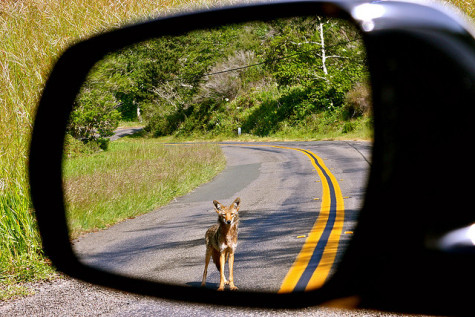 The park where I first saw the dog is a patch of green that’s separated from the mountains by several highways and several hills. There’s a coast guard station on one side, houses on the other, a mid-speed thoroughfare bordering its front.
The park where I first saw the dog is a patch of green that’s separated from the mountains by several highways and several hills. There’s a coast guard station on one side, houses on the other, a mid-speed thoroughfare bordering its front.
Early one morning, when it was foggy and my eyes were foggy, too, I saw a woman standing at the edge of the grass. I stopped to watch the dog, to see what I was missing. Its ears were pointy, and it was looking back at the woman. Then I watched the woman walk over to a pair of park workers who were bagging the trash. “Have you called animal control about that?” she asked them.
That? I squinted again.
The workers both shrugged. “They put up some signs,” they said. I looked around. Sure enough, there were signs. Coyote in park, they said.
The first thing I thought of when I looked at the coyote again was not animal control. It was a kind of excitement. Coyote made me think of moonlit nights near the Canadian border, of eerie yipping and howling that had seeped into my dreams and appeared again as tracks when I walked around the snow near the cabin where I lived, with another writer, near the Kettle River. Here again was a little piece of wildness here, in the suburbs, about as far from the mountains as you could get without running into the sea.
Later that day, when I was more awake, I took the sighting more seriously. The drought seems to have brought this young coyote—along with other animals—down from the parched mountains to urban areas and the culinary opportunities that come with them. (Ant Week-ish connection: The drought has also contributed to the fact that our house, and many others, is filled with thirsty ants.) Although coyotes aren’t always the culprits when it comes to missing chickens and other household pets; a group studying coyotes in the Chicago area found that the most common food items in coyote scat were rodents, fruit, deer, and rabbit—not pets or garbage.
This particular coyote seems to be all alone, and I wonder how long he (or she) will stay. There’s another pack of coyotes that’s been haunting a nearby, much larger park, and I wonder if this one will meet up with them.
Although it doesn’t have to meet another coyote. The area is surrounded by rambling dog parks. I started to imagine the possibilities—and found the word coydog (which I’m not quite sure how to pronounce).
The urban coyote researchers suggest that the likelihood of finding a coydog den in the big city (or the nearby park) is low, particularly because of the different patterns of their breeding period (coyotes are seasonal, dogs are not). But intermingling does happen, and may even precipitate further coyote appearances in surprising places: this spring, one study suggested that hybrids may use ecosystems in different ways than their parents.
I did see an interesting coyote hybrid this weekend during a visit to the Ojai Foundation, an organization that’s trying to expand connections between people and the natural world. The sculpture, for that’s what it was, had the hindquarters of a coyote and the head and a dolphin—two creatures that were and are important to the native Chumash.
The person showing me around the foundation’s land told me that the combination showed the perfect balance between wisdom and wiliness, between intelligence and trickster magic. Maybe we’ll need both qualities to learn how to deal with the new arrivals in our midst, whether they’re just visiting until the weather changes or they’re here with us for good.
**
Image by Tony Koloski via Flickr/Creative Commons